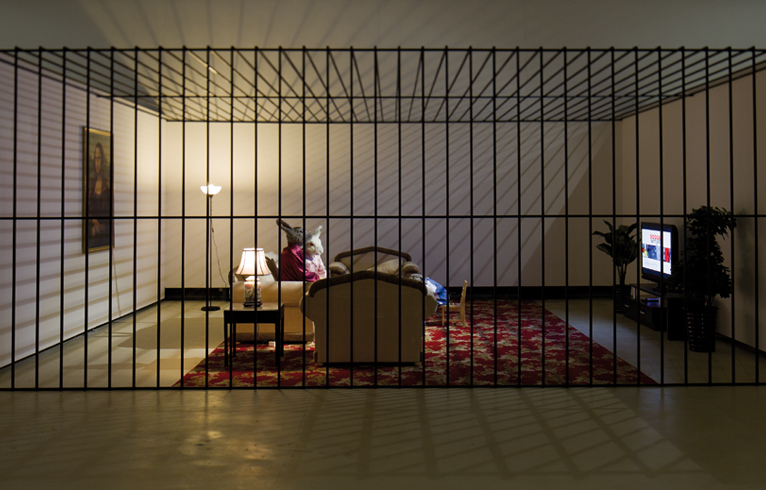QIU ANXIONG: ZOO
| December 27, 2011 | Post In LEAP 11

In the vast, far-stretching OCT gallery space, curved walls separated two works produced for this exhibition of Qiu Anxiong’s new work. The work A Study in Autopsy appeared to simulate the organs and circulatory system of a human body, while Surplus Value featured projected images of a running horse, accompanied by racing equipment. On a purely visual level, these two pieces seemed to hint at a nostalgia for a forgotten mechanical aesthetic; both also possessed a conventional Dadaist quality, albeit one trapped in an imagination of industrial society from a postindustrial perspective. Gazing at this projection of a horse in motion, one might mistakenly hear the sound of film running through a projector. Alas, the only acknowledgement of an immediate reality is found dangling from the horse’s saddle: a tag displaying the horse’s club name. The density of the exhibition’s layout also served as its core, and clearly differentiates it from the artist’s solo exhibition of the same name, and much of the same work, seen last year at Boers-Li Gallery in Beijing.
Works from this exhibition that have been shown before include The Power of Heresy, The Sceptic and Revolution; the arrangement of these three within the space formed a triangular symmetry. A series of figurative paintings based on photographs taken of zoos supplements the viewpoint of humans with the viewpoint of animals, the latter seemingly the focal point of the show. A bear lurking in the corner of one photograph at once demanded empathy and functioned as an introspective entry point to this series of images, the exit point for which is presented at the far end of the exhibition hall in one of the final works of on display, a piece titled Unspeakable Happiness.
If the majority of the metaphors contained within the works featured in “Zoo” function subtly, and textually, then Cute Rabbit Family is, conversely, a clear parody of middle-class life and its illusions. The cliché of art and “quality of life” is trapped inside a cage, such that even those idyllic scenes are rendered crude, incapable of concealing the myriad hypocrisies of lies.
Meanwhile, wrapped in white flannel, Leopard Lair visually and literally seemed like an outsider. As the artist said: “Of the whole exhibition, the only hint of freedom can be found in the piece Migration, which represents something irresistible and unavoidable.” Migration is a set of new works consisting of deer antlers arranged to signify a group of animals in migration, it simultaneously portrays the very opposite, the independent individual. Here, this crowd of individuals eagerly crane their necks toward the gallery exit. Meanwhile, these “bodies” of animals, abstractly speaking, look like coat racks, visually stuck in place; their vertical immobility contradicts the imaginary freedom of horizontal migration. This paradox, a tug of war between freedom and non-freedom, perhaps reflects the essential ideas of this exhibition more clearly than does the notion of “captivity.”
The novel Animal Farm has been mentioned more than once to be the background of “Zoo,” but the allusions borrowed from the novel’s characters here have developed their own distinct system: In “Zoo,” personal utopia wears the camouflage of anti-utopian reality, and a utopian point of entrance leads the viewer to a dystopian exit. Using “appropriation” as its point of departure, the narrative developed by the artist has to be brought back to and investigated in a broader context, including the meta-narrative that hovers around it and the relevant critique and reflection. If here “Utopia” is the meta-narrative, then as various, distinct utopias emerge, so will their corresponding anti-utopias: as when a two-sided coin is suddenly tossed into the air, and the person waiting to catch it, hands outstretched, has no idea on which side it will land. Nikita Yingqian Cai (Translated by Dominik Salter Dvorak)

